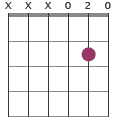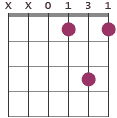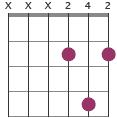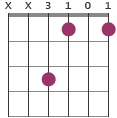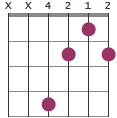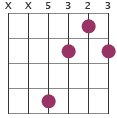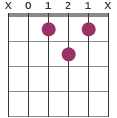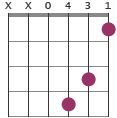Dim chords
The dim (diminished) chords are quite uncommon, but it's still good to be familiar with this chord category. If you play a dim chord you will hear that these chords lack harmony and this is because of the structure of the notes.
A common function for these chords is to be used as a chromatic transposition chord, like an in-between chord, also called a passing chord – this is most common in jazz. If you are interested in the theory, the dim chord consists of a flatten third and a fifth besides the root. If we compare the structure of a C major and a C diminished, the notes are C - E - G (C) and C - Eb - Gb (Cdim). A diminished chord can be written with an abbreviation "dim" (Cdim) or a symbol "º" (Cº).
Dim chords (closed and open positions)
C#dim
Ddim
D#dim
Fdim
F#dim
Gdim
Adim
Bdim
Comments
Concerning the "non-movable" open and closed dim chords, in some cases an alternative bass note is used for making the chords easier to play.
Notice that the pictured C#dim more correctly is spelled C#dim/G.
To include more strings, C#dim can also be played as XX5650. Notice that the pictured D#dim more correctly is spelled D#dim/A.
An option with the root as bass note is X642XX. Notice that the pictured B#dim more correctly is spelled Bdim/D.
More chords
More dim chords in open positions:
C#dim / Dbdim - X42020 / XXX654
A#dim / Bbdim - X1X020
In progression: D - C#dim - Em/B - A
Movable shape
The easiest way to learn dim chords is to memorize a movable shape. The lowest note is the root (see list below for full overview) in the diagram:
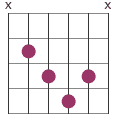
All diminished chords with same movable shapes listed and written in short notation. Two different shapes are in some cases presented for the dim triads, which both have similar bass and root notes.
Cdim - X3454X
C# / Dbdim - X4565X
Ddim - X5676X
D# / Ebdim - X6787X
Edim - X7898X
Fdim - X 8 9 10 9 X / 1231XX
F# / Gbdim - X 9 10 11 10 X / 2342XX
Gdim - X 10 11 12 11 X / 3453XX
G# / Abdim - 4564XX
Adim - 5675XX
A# / Bbdim - 6786XX
Bdim - X2343X
Chord formula
The dim triad is built with the formula 1-b3-b5.
Chord progressions with dim chords
The typical function of a dim chord in sequences is as a chromatic passing chord:
F (133211) - G (355433) - G#dim (4564XX) - Am (577555)
C (X3555X0) - C#dim (X4565X) - G (355433)
Dm - A7 - Gm - F6 - Bdim - Bb6 - Dm
Gm - Cm - D - Gm - Cdim - Gm
Ab - Dbm - Adim
Bbmaj7 (6X776X) - Bdim (7X676X) - Cm7 (8X888X)
The
dim chord wants to resolve to the tonic. Therefore, a C major chord will sound right after a Bdim, D major will sound right after a C#dim and so on. Also, resolving to the related minor will sound right, for example, Bdim to Am.
Dim chord in blues:
E7 (XX6757) - Edim (XX5656) - B7 (XX4445)
All dim chords can be
moved in minor 3rd intervals. Meaning that you, for example, can play movable dim chord types with jumps of four frets distances, like this progression:
Cdim (X3454X) - Ebdim (X6787X) - Gbdim (X 9 10 11 10 X)
Or:
Cm7b5 (X3434X) - Ebm7b5 (X6767X) - Gbm7b5 (X 9 10 9 10 X
Dim chords may be more convenient for the piano since only one finger has to be move for in sequence such as C - C#dim or D - D#dim whereas a guitarist has to reposition the fingers to a higher degree (this is as least true when it comes to open chords).
See also diminished 7th chord.
Back to chord types
